How to connect an outlet block: installation rules and connection diagrams
Where it is necessary to connect an interacting group of household appliances, an outlet block is installed, including two to four electrical points. Installation and connection of this option differs from the same actions with a conventional outlet. In order for the result to please reliability, you need to know the subtleties. Do you agree?
We will tell you in detail how to connect the outlet block, what connection options exist taking into account consumers. Here you will find out what installation rules should be considered when installing such a modular device. The information submitted for consideration is based on the PUE.
The detailed technology of installation and connection of outlet blocks was supported by schemes, step-by-step photo guides, and video.
The content of the article:
The device and installation locations of outlet blocks
The design of the outlet unit differs from the usual outlet only in the number of "seats". It consists of a plastic case and an internal part represented by terminals with contacts and terminals to which the spring for the plugs are attached.
Most modern models are equipped with grounding contacts, which are designed to increase the security of the system and reduce voltage from all connected electrical appliances through the unit.
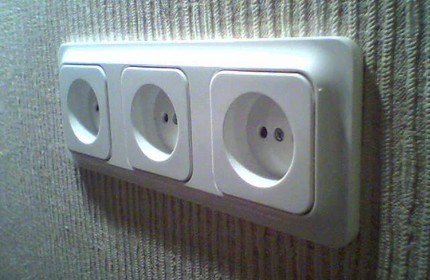
Outlet blocks are of two types:
- Designed for hidden wiring. They are installed in the thickness of the wall with the help of a module made of cup-shaped rosettes;
- Designed for open wiring. They are mounted on the wall surface with the help of a plate made in the form of a socket.
In addition to the two main varieties of outlet blocks, there is also a very practical retractable type. They are easily mounted in the countertop or in the cabinet, from which they are put forward during the period of operational need.Their principle of operation is similar to power supplies located on / in the wall.
Outlet blocks often set in the kitchens, placing them at the desk at a height of 10 cm, inside the kitchen cabinets and behind the walls of adjacent cabinets at a level of 30-60 cm from the finish floor. Built-in sockets are convenient to use when connecting a group of not powerful household appliances: hoods, crock-pots, refrigerators ...
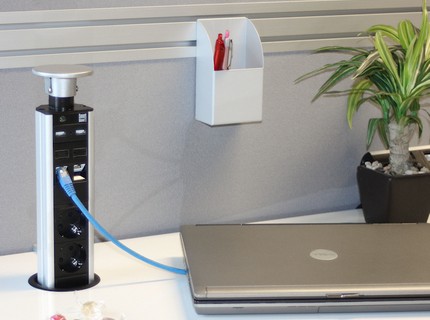
When arranging halls and living rooms, they are placed near computer desks or behind a TV screen. Outlet groups of three electric points can often be found in bathrooms. But in this case, devices with waterproof enclosures are used, placing them at a distance of at least 60 cm from the water source.
Connection methods tailored to consumers
The connection of the outlet group of one group is carried out by a loop method. It involves the connection of all elements of the group to a common power supply line. The circuit created by the loop method is designed for a load whose indicator does not exceed 16A.
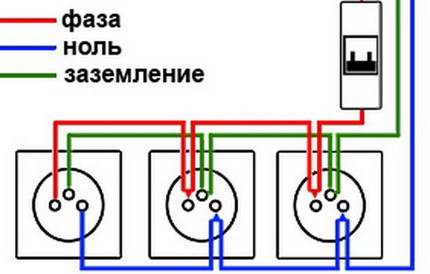
Today, the connection of the outlet block is often carried out in a combined manner, which is based on a parallel circuit. This method is actively practiced in European countries. We use it to provide a separate line of powerful consumers.
Parallel connection involves laying two cables from the junction box:
- the first is sent as a loop, feeding four out of five outlets of a 5-seater unit;
- the second - is brought separately to the fifth point of the outlet group, which will be intended for power supply powerful appliance.
The method is good in that it ensures the operability of a single point and makes it independent of the functioning of other circuit participants located nearby.
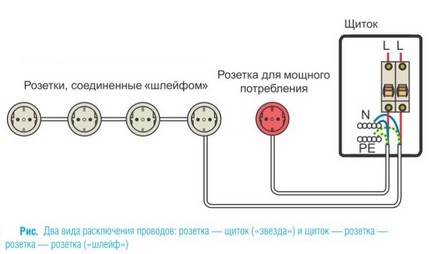
The only drawback of the circuit is the increase in cable consumption and labor costs of the electrician.
Both the loopback and the combined connection method can be closed or open. The first involves hollowing out channels in the wall to lay lines and “nests” for the connectors, the second is realized by laying a PE conductor on the wall surface.
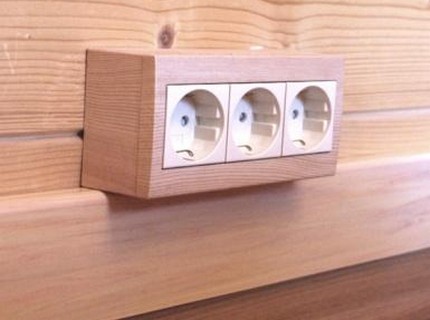
The use of plastic cable channels increases the safety and aesthetics of open wiring. Most of them are equipped with partitions, between which they lay a line. It is convenient to monitor the state of the PE conductor through a removable front.
Installation Instructions
Choosing a mounting method, whether it be an outdoor installation or internal wiring, depends on the material with which you have to work. The walls in the house can be concrete or brick, or made of wood or drywall.
Whether you plan to ditch concrete in a prefabricated house or limit yourself to installing a surface unit with open wiring - you decide.
Preparatory work
The first thing to do is to de-energize the area where the work will be performed.
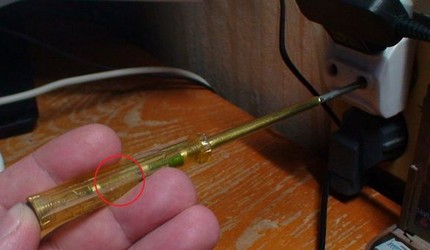
In houses of the old construction, where there are no automatic machines installed, in order to de-energize the room you only need to unscrew the plugs.
From materials it is necessary to prepare in advance:
- outlet block;
- decorative strip;
- wires for jumpers;
- cable for wiring;
- Sockets connected in blocks;
- gypsum or alabaster.
The choice of the outlet block should be based on the quality of the product, as well as the possibility of a separate connection of PE conductors.
Of the tools required:
- hammer drill equipped with a drill bit D 70 mm;
- building level;
- tape measure, ruler and marker;
- wiring tool kit;
- container for mixing gypsum;
- putty knife.
The choice of a crown for a perforator depends on the material you have to work with. Nozzles for drywall or the same concrete differ in operational parameters and, accordingly, in price.
Wall Marking
The convenience of installing and connecting the outlet group depends on the correct marking. Before starting work, make sure that there are no communications under the wall. When working with a drywall base, it is important not to get on its supporting profile.
Using a ruler, level and marker, mark the place where they plan to install. When applying markup, they are guided by how many electric points the group includes. Cross lines mark the centers of future holes.
In the center of future holes, recesses are removed. It is important to ensure that the drill bit guide does not "go" to the side. A little trick: since when creating a socket block, it is rather difficult to achieve horizontal hole arrangement, you can use a slightly larger crown with a diameter of 80 mm for operation.
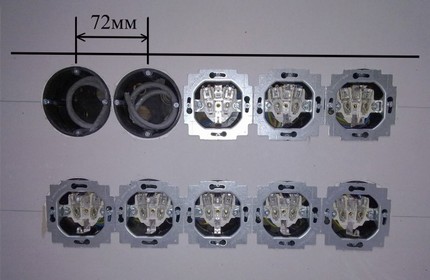
In order to avoid erroneous drilling of holes when concealed cable laying, it is better to make a drawing at the installation stage in which to display the location of the wires.
The methods of wiring and laying the cable in the apartment are described in detail in popular article our site.
Creation of a shtrob and "landing" places
When preparing “seats” in a concrete or brick wall, drilling along the marked crosshairs begins at low speeds, without forgetting to control the position of the drill.
To ensure mounting accuracy, the hole is first marked with a small diameter drill. Only after this a crown is inserted, which makes a recess along the contour of the future "seat".
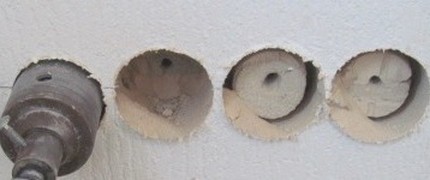
The wall material remaining in the holes is hollowed out with a perforated chisel. After that, the grooves necessary for the connecting protrusions are laid between the holes rosette.
When planning to carry out hidden wire laying, grooves are hollowed out along the planned lines. When washing one of the points of the block with a separate line, it is necessary to lay another furrow from the shield.
All holes and ditches are cleaned of crushed pieces and dust with a brush or cotton cloth. In the future, to protect the PE conductor and ease of laying, it is better to run the cable in a corrugated sleeve.

If desired, gating the walls can also be done in the “old-fashioned” way using a chisel and a hammer. But be prepared that it will take more effort and time to implement this method. And to make recesses with a chisel in a brick for laying a cable is a difficult task, which does not always give a neat desired result.
It is much easier to work with a drywall base. To make seats, it is only necessary to cut round strobes with the help of a drywall nozzle according to the marking. The main thing is not to press hard so as not to break the fragile base.
The specifics of fixing the sockets
For fastening the sockets, it is most convenient to use special glasses interconnected with plastic clips. Designs of standard sizes of round or square shape provide rigid fastening of elements in the plane.
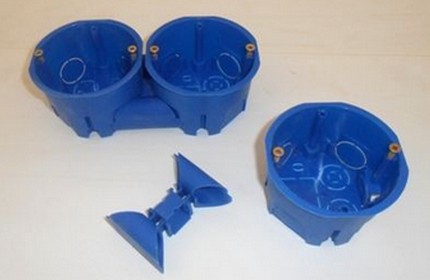
Alabaster or gypsum mortar is used to fix podrozetniki in brickwork or wall. The powder is diluted with water in a ratio of 4: 1. When working with these creamy formulations, it should be remembered that they quickly set.
The powder must be diluted in small portions and quickly put in the hole until the mixture has hardened. The same solution is coated with the outer side faces and the bottom of the connected glasses adjacent to the surface, after which the entire block is inserted into the hole.
The position of the buried cups is adjusted with the help of a level, not allowing the protrusions of the edges to extend beyond the wall plane.
After verifying the correct position of the sockets, the edges are coated with a liquid solution, giving the plane a maximum smooth surface. The remains of alabaster or gypsum can be used to mask the wires laid to the outlet.
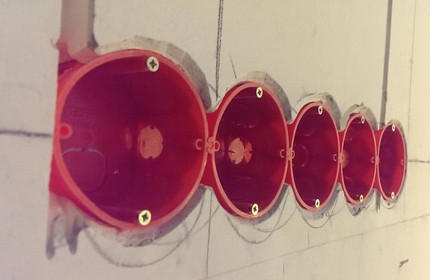
Mounting cups for drywall are additionally equipped with special feet. By pressing against the back of the surface of the plate, these tabs pull the glass into the hole.
Buried in the wall podrozetniki should not abut and protrude beyond it. If the gap between the wall and the gypsum board is insufficient to accommodate the socket, the hole in the wall is further deepened.
The only exception is the option when it is assumed that the surface is tiled or finished with plaster. In this case, the podrozetnik is made slightly protruding outside the wall by 5-7 mm.
Subtleties of connecting electricians
After the solution acquires the desired strength, go to the connection of the indoor unit. To connect the sockets in a loop-through manner, the wires laid from the junction box lead into the first socket.
Immediately before this, the ends of the cable are stripped 10-15 mm from the lash. You can do the work with a sharpened knife. But to achieve maximum accuracy, experienced owners recommend using side cutters.
In order to be able to make a new connection in the future if necessary, the masters recommend leaving a small supply cable supply from the junction box during stripping.During installation, it can be folded inside the undergrowth in the form of a spiral of large diameter or in the form of a snake.
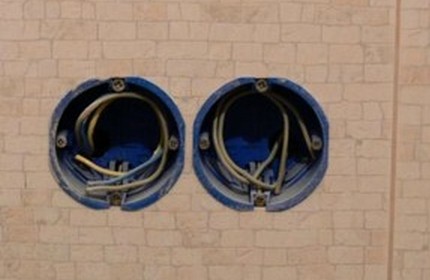
In advance, cuts of colored wires are prepared to create jumpers. The cross-section of the jumpers must correspond to the conductors of the supply line. Jumper wires should not be made too long. Otherwise, during the connection process they will interfere and do not allow the socket to "sit" tightly in the mounting box. The cut-off wires also strip the insulation by about a centimeter.
Through the adapters previously cleaned from the remnants of gypsum, the cavities of the rosettes pass the wires. To simplify installation, the ends of the conductors are folded in the direction of the terminal arrangement.
The protective cover is removed from the socket unit itself, then the clamping screws are loosened by 5-6 mm. The stripped end of the phase wire of the supply cable is led to the first outlet, taking into account the position of the terminals. From it, through the PE contacts, the conductor and the neutral wires of the supply cable are sent to a second outlet.
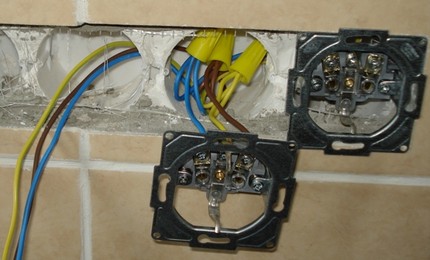
By the same principle, all subsequent outlets are connected. Sockets with neatly laid wires are not tightly tightened with screws. When polishing outlets, the polarity of the contacts must be observed: the phase is removed from the terminal with the phase conductor, and from the zero - zero.
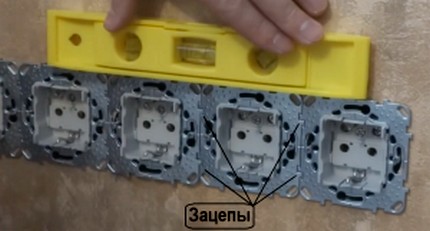
When connecting a protective conductor, the basic PUE requirement, which states that all connections of this wire must be non-separable, must be strictly observed. Underestimating the importance of installation quality is fraught with the fact that in a dangerous incident, the risk of electric shock increases significantly.
So, if contact with the ground disappears in the head power outlet during installation, the circuit participants following it lose their protective zero. In the future, if the mains voltage is accidentally hit on the case, for example, due to a malfunction of the iron, the cases of all electrical appliances connected to the supply wire will be energized.
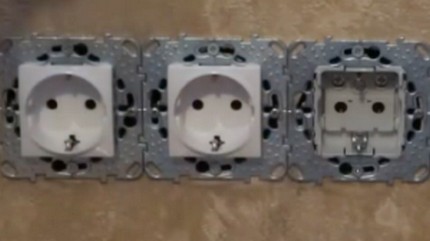
Podrozetniki with connected cores to the corresponding terminals are inserted into the wall holes and fixed with side clamps. Then check the reliability of the installation of all devices, using the level to adjust their position. If necessary, bare sections of wire are wrapped with insulating tape or insulated with a heat-shrinkable sponge.
After this, it remains only to “squeeze” all the screws, fix the case in the socket and put the decorative cover back in place.
Step-by-step photo tutorial:
If the unit is connected correctly, all sockets should work, and the frame with the sockets should not move when used.
Conclusions and useful video on the topic
The video materials we have proposed will clearly help you understand how to properly install a power outlet block.
Video # 1. Arrangement of socket boxes for the outlet panel:
Video # 2. Installation instructions for the five-outlet block:
Installing a socket unit for the complexity of installation is not much more difficult than connecting a conventional or dual outlet. Having shown attention and the utmost accuracy, any owner who owns only the basic skills of electrical work can carry out the installation.
Want to talk about your personal experience in installing and connecting group outlets? Have useful information or have questions while reading this article? Please write comments in the block below.

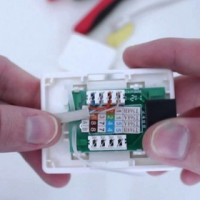 How to connect a telephone socket: connection diagram and installation rules
How to connect a telephone socket: connection diagram and installation rules 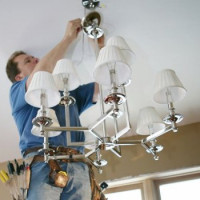 How to connect a light bulb through a switch: schemes and connection rules
How to connect a light bulb through a switch: schemes and connection rules 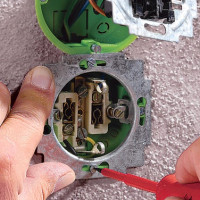 How to connect a switch with one key: rules and connection diagrams
How to connect a switch with one key: rules and connection diagrams 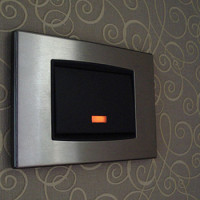 How to connect an LED switch: rules for connecting a backlit switch
How to connect an LED switch: rules for connecting a backlit switch 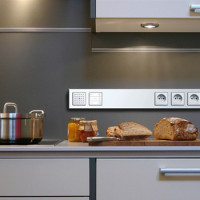 Placement and installation of sockets in the kitchen: the best schemes + installation instructions
Placement and installation of sockets in the kitchen: the best schemes + installation instructions 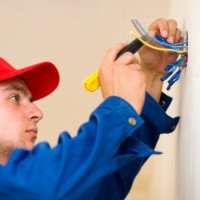 How to connect a double switch to two bulbs: schemes + connection tips
How to connect a double switch to two bulbs: schemes + connection tips  How much does it cost to connect gas to a private house: the price of organizing gas supply
How much does it cost to connect gas to a private house: the price of organizing gas supply  The best washing machines with dryer: model rating and customer tips
The best washing machines with dryer: model rating and customer tips  What is the color temperature of light and the nuances of choosing the temperature of the lamps to suit your needs
What is the color temperature of light and the nuances of choosing the temperature of the lamps to suit your needs  Replacement of a geyser in an apartment: replacement paperwork + basic norms and requirements
Replacement of a geyser in an apartment: replacement paperwork + basic norms and requirements
The wall outlet block is a very convenient and functional thing. But during installation, if you do not have experience in such matters, problems will certainly arise. It is very important to correctly mark and install the sockets. The distance between their centers must be exactly 72 mm, otherwise the decorative panel will never fall into place. Do not rush to fix mortars in the wall with mortar until you are sure that the panel will be installed correctly.
Since when has the center distance in the mounting boxes become 72 mm, not 71 mm?
Yes, the standard 71 mm for the center distance in the mounting boxes - this is if you take trusted manufacturers. But I had several cases when these standards were not respected. I had to really try to fix it without buying new boxes.
Once there was a case that I took five of the sockets, fastened them together, and the distance between the extreme axes was not 284 mm, as it should be, but 281.5 mm. So do not be surprised that someone has options with a center distance of 72 mm. It’s good that this is an exception to the rule, and not a common occurrence.
How am I tormented with that assembly then, so that the client does not spend money on new ones, and after all, it was purchased undersockets for the entire three-room apartment. I didn’t buy, if that.
Always, when I watched the installation of the outlet block in the house, it seemed that it was very simple and great mind to drill a hole and insert a socket there, is not necessary. But everything turned out to be much more complicated. When I myself was faced with the fact that the child turned out the socket in the room, then I tormented myself for a very long time with the connection of all the wires, so it could not have done without a master at all.
Something did not work out with alabaster, even using citric acid as a moderator. I use mounting adhesive for plasterboard PERLFIX from Knauf for fixing subzetnets. The result is excellent.